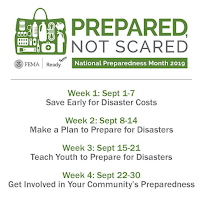#14,930
One of the stark differences between the United States - and a great many other countries around the world - is that our government agencies (FEMA, READY.GOV, CDC, etc.) actively promote individual and family preparedness.
The Month of September is designated National Preparedness Month, each May NOAA and the National Hurricane Center hold a Hurricane Preparedness Week, in March there is a National Severe Weather Week and a Tsunami Preparedness Week, and in October most of the states around the country take part in a yearly Shake-Out earthquake drill.The standard advice is that every household should have at least 2-weeks worth of food and water, a first aid kit, and an NWS Weather radio. Ready.gov urges every household have an emergency plan, and have even published recommendations on how to prepare before a pandemic.
In 2017, the CDC released a 16-page Household Pandemic Planning guide, which emphasizes the use of NPIs - or Non-Pharmaceutical Interventions - during a pandemic.
Get Your Household Ready for Pandemic Flu [PDF – 16 pages]Three weeks ago, in CDC Interim Guidance: Infection Control For Home Care Of Suspected Or Confirmed 2019-nCoV Cases, we looked at specific advice for the care of COVID-19 patients at home.
They urge people to buy an umbrella while the sun is shining, because they know that once the rain starts, umbrellas will be in very short supply. And at that point, banging the preparedness drum can cause panic buying, or worse.
Sadly, far too people take these recommendations to heart, and many find themselves scrambling to prepare when a blizzard, hurricane, or some other disaster looms. But at least the information is out there for people who want it.With a few notable exceptions - like Japan's Earthquake Preparedness Messaging - Tokyo's X Day - personal and family preparedness gets very little mention around the world. Perhaps it's a cultural thing, based on a deep and pervasive denialism that anything truly `bad' will happen, or a firm belief that during a crisis governments will find a way to provide.
But it has always seemed short sighted to me. And never more so than now, with a global health crisis looming.Fourteen years ago we looked at a Lancet study that predicted, based on a 1918-like pandemic scenario, could claim as many 62 million lives, and that 96% of those deaths would occur in developing countries.
Estimation of potential global pandemic influenza mortality on the basis of vital registry data from the 1918—20 pandemic: a quantitative analysis
Prof Christopher JL Murray DPhil , Prof Alan D Lopez PhD, Brian Chin ScB, Dennis Feehan AB , Prof Kenneth H Hill PhDThree years ago, in Are We Prepared to Help Low-Resource Populations Mitigate a Severe Pandemic?, we looked at many of the reasons why poorer countries will fare far worse during a pandemic, and some ideas on how to change that (Note: new link to paper).
Ten years after the last pandemic, at least for most of the world, I have to wonder.
Where are the practical recommendations - to individuals and families - on how to prepare for a pandemic? Guidance on how to safely care for someone in the home who is sick with the novel coronavirus? How to implement community NPIs, or how to make a homebrew facemask?This is the sort of thing I would expect the WHO to take the lead on, but most of their advice - so far, at least - appears geared more towards macro issues and governments rather than individuals. Perhaps that will change, but right now there is a genuine need around the world, and time is growing short.
While I recommend people try to avail themselves of the CDC's excellent guidance, not everyone has access to the internet (or knows where to find it), and their advice really needs to simplified and condensed, translated into scores of languages, and be tailored to local customs and available resources.
Basic information - presented with simple graphics and in multiple languages - could save a lot of lives, if it were presented to vulnerable populations early in a pandemic.While ideally this sort of information would have already been prepared, and made publicly available (much in the way the CDC has done for years) long before a pandemic threatened, it isn't too late.
But the clock is ticking.
